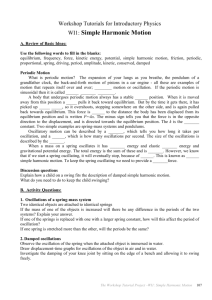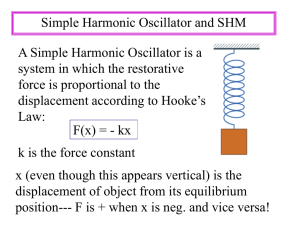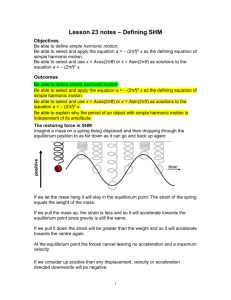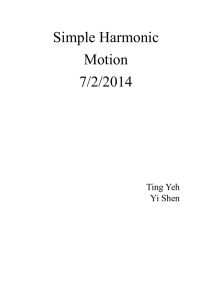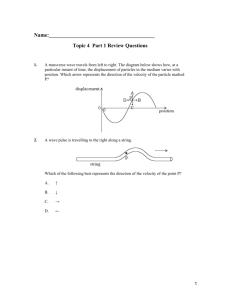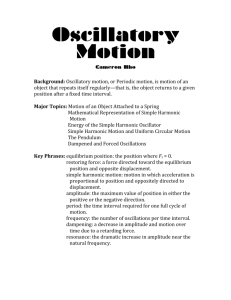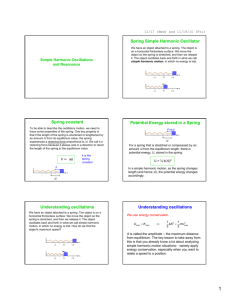Solutions to WI1: Simple Harmonic Motion
advertisement
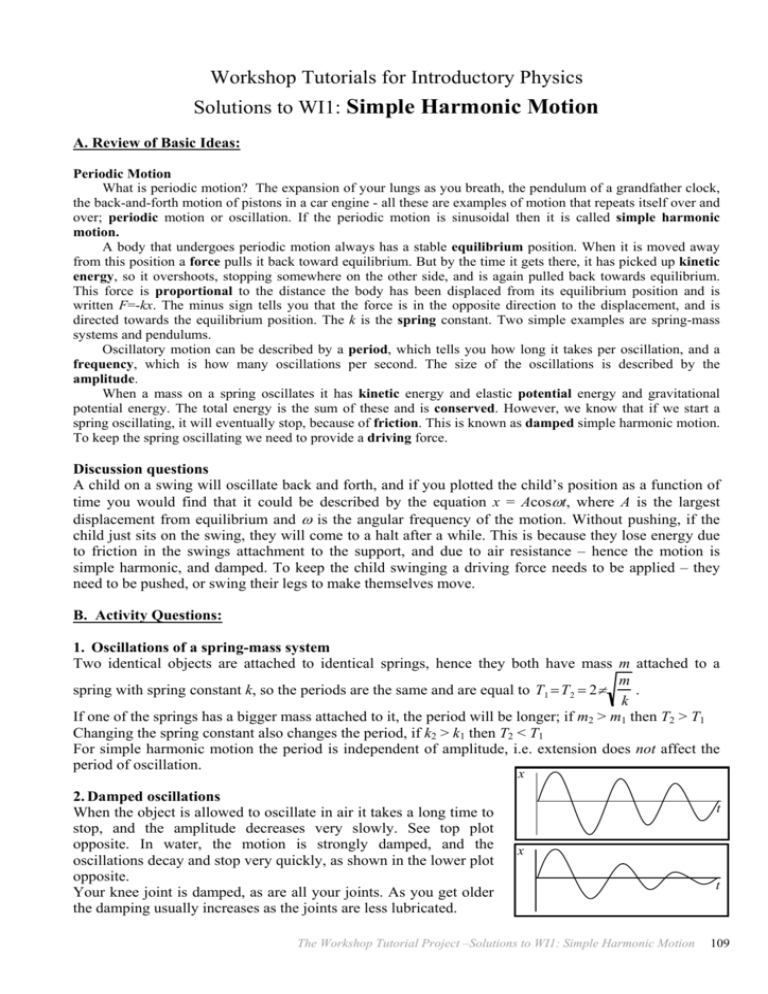
Workshop Tutorials for Introductory Physics Solutions to WI1: Simple Harmonic Motion A. Review of Basic Ideas: Periodic Motion What is periodic motion? The expansion of your lungs as you breath, the pendulum of a grandfather clock, the back-and-forth motion of pistons in a car engine - all these are examples of motion that repeats itself over and over; periodic motion or oscillation. If the periodic motion is sinusoidal then it is called simple harmonic motion. A body that undergoes periodic motion always has a stable equilibrium position. When it is moved away from this position a force pulls it back toward equilibrium. But by the time it gets there, it has picked up kinetic energy, so it overshoots, stopping somewhere on the other side, and is again pulled back towards equilibrium. This force is proportional to the distance the body has been displaced from its equilibrium position and is written F=-kx. The minus sign tells you that the force is in the opposite direction to the displacement, and is directed towards the equilibrium position. The k is the spring constant. Two simple examples are spring-mass systems and pendulums. Oscillatory motion can be described by a period, which tells you how long it takes per oscillation, and a frequency, which is how many oscillations per second. The size of the oscillations is described by the amplitude. When a mass on a spring oscillates it has kinetic energy and elastic potential energy and gravitational potential energy. The total energy is the sum of these and is conserved. However, we know that if we start a spring oscillating, it will eventually stop, because of friction. This is known as damped simple harmonic motion. To keep the spring oscillating we need to provide a driving force. Discussion questions A child on a swing will oscillate back and forth, and if you plotted the child’s position as a function of time you would find that it could be described by the equation x = Acosωt, where A is the largest displacement from equilibrium and ω is the angular frequency of the motion. Without pushing, if the child just sits on the swing, they will come to a halt after a while. This is because they lose energy due to friction in the swings attachment to the support, and due to air resistance – hence the motion is simple harmonic, and damped. To keep the child swinging a driving force needs to be applied – they need to be pushed, or swing their legs to make themselves move. B. Activity Questions: 1. Oscillations of a spring-mass system Two identical objects are attached to identical springs, hence they both have mass m attached to a m spring with spring constant k, so the periods are the same and are equal to T1 = T2 = 2π . k If one of the springs has a bigger mass attached to it, the period will be longer; if m2 > m1 then T2 > T1 Changing the spring constant also changes the period, if k2 > k1 then T2 < T1 For simple harmonic motion the period is independent of amplitude, i.e. extension does not affect the period of oscillation. x 2. Damped oscillations When the object is allowed to oscillate in air it takes a long time to stop, and the amplitude decreases very slowly. See top plot opposite. In water, the motion is strongly damped, and the oscillations decay and stop very quickly, as shown in the lower plot opposite. Your knee joint is damped, as are all your joints. As you get older the damping usually increases as the joints are less lubricated. t x The Workshop Tutorial Project –Solutions to WI1: Simple Harmonic Motion t 109 3. Charting pendulum motion The line drawn is sinusoidal, and can be described by the equation x = Acosωt, where A is the initial, and maximum, displacement, ω is the angular frequency of the motion and is equal to 2πf where f is the frequency of oscillation, t is the time, and x is the displacement at that time t. C. Qualitative Questions: 1. Imagine you have a spring and you cut it into two pieces, one a third the length of the original spring and one two thirds the length of the original. a. The more coils a spring has the easier it is to stretch it. The shorter spring, with only half as many coils, will not stretch as much as the longer spring when the same force is applied to it by hanging a mass on it. b. The spring constant, k, is given by the extension, ∆x, for a given applied force F: F = -k∆x or k = F /∆x. For the same force the longer spring has a greater extension, therefore it has a smaller spring constant. 2. Bungy jumping is an increasingly popular sport. max a ↓ a. See opposite. x zero v, b. See opposite, the region which is approximately max v, max a. period, simple harmonic motion is after the initial jump when zero a T. you oscillate up and down before being untied. c. See opposite. The speed is greatest as you pass through the equilibrium position, the acceleration is t greatest as the maximum and minimum displacements. approx. SHM d. You momentarily stop at the top and bottom of each max a ↑, oscillation. At these points your acceleration is retinas detach here, maximum, and hence the force you experience will be zero v. maximum at these points. e. When you jump you go head first, and the first minimum is where you are most likely to have your retinas detach, as this is where the acceleration and hence the force will be greatest. D. Quantitative Question: A 100 g bungy fish is bobbing up and down with amplitude 6 cm = 0.06 m and frequency 1 Hz. At time t = 0, when you first observe the bungy fish, it has a displacement of +0.06 m from its equilibrium position. a. The angular frequency of the bungy fish is ω = 2πf = 2 × π × 1 Hz = 2π rad.s-1. b. The formula which describes simple harmonic is x = Acos(ωt +φ), where φ is the phase constant, A is the maximum displacement, ω = 2πf where f is the frequency, t is the time, and x is the displacement at time t. For the bungy fish: x = 0.06 m cos (2π rad.s-1 × t) When we first observe the bungy fish, at t = 0, it has its maximum displacement, A = 6 cm. Hence the phase angle is φ = 0. 6 cm c. At t = 1 s, x = 0.06 m cos (2π rad.s-1 × 1 s) = 0.06 m, x back to the maximum. This makes sense because the frequency is 1 Hz, so the 1s 0.1 s period is 1 s. The bungy fish will have performed one t complete oscillation and returned to its starting point at t = 1 s. d. At time t = 0.1 s, x = 0.06 m cos (2π rad.s-1 × 0.1 s) = 0.049 m = 5 cm. e. We can find the force constant, k, from the angular frequency using ω = give k = ω2m = (2π rad.s-1)2 × 0.1 kg = 3.9 kg.s-2. 110 The Workshop Tutorial Project – Solutions to WI1: Simple Harmonic Motion k m , which we rearrange to

